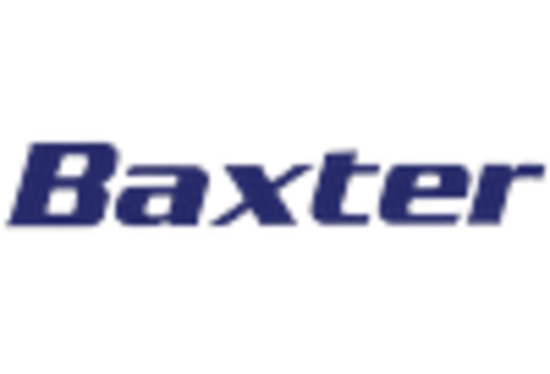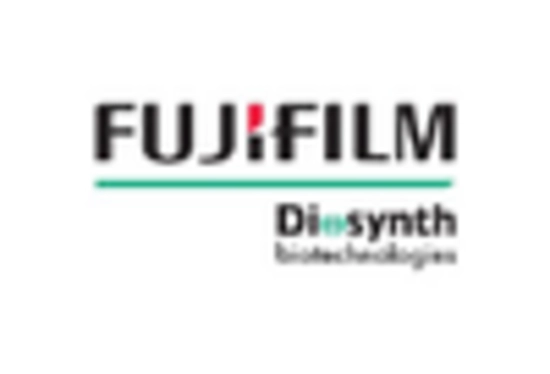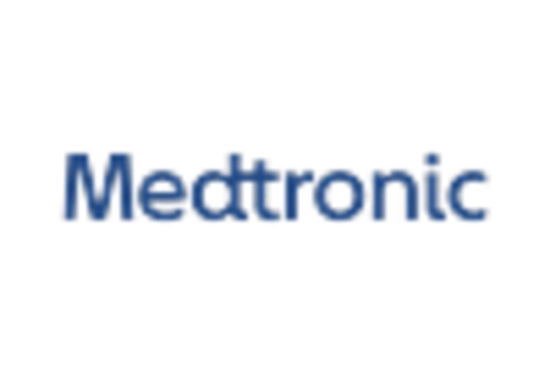Drug Delivery
Tissue Engineering
Regenerative Medicine
Biological Research
Microencapsulation
Nanoencapsulation
Spray Drying
Coacervation
Pharmaceuticals
Biotechnology
Research Laboratories
Academic Institutions
Polymers
Alginate
Hydrogels
Silicon
North America
Europe
South America
Asia Pacific
Middle East and Africa
North America Outlook (USD Billion, 2019-2035)
North America Live Cell Encapsulation Market by Application Type
Drug Delivery
Tissue Engineering
Regenerative Medicine
Biological Research
North America Live Cell Encapsulation Market by Technology Type
Microencapsulation
Nanoencapsulation
Spray Drying
Coacervation
North America Live Cell Encapsulation Market by End Use Type
Pharmaceuticals
Biotechnology
Research Laboratories
Academic Institutions
North America Live Cell Encapsulation Market by Material Type
Polymers
Alginate
Hydrogels
Silicon
North America Live Cell Encapsulation Market by Regional Type
US
Canada
US Outlook (USD Billion, 2019-2035)
US Live Cell Encapsulation Market by Application Type
Drug Delivery
Tissue Engineering
Regenerative Medicine
Biological Research
US Live Cell Encapsulation Market by Technology Type
Microencapsulation
Nanoencapsulation
Spray Drying
Coacervation
US Live Cell Encapsulation Market by End Use Type
Pharmaceuticals
Biotechnology
Research Laboratories
Academic Institutions
US Live Cell Encapsulation Market by Material Type
Polymers
Alginate
Hydrogels
Silicon
CANADA Outlook (USD Billion, 2019-2035)
CANADA Live Cell Encapsulation Market by Application Type
Drug Delivery
Tissue Engineering
Regenerative Medicine
Biological Research
CANADA Live Cell Encapsulation Market by Technology Type
Microencapsulation
Nanoencapsulation
Spray Drying
Coacervation
CANADA Live Cell Encapsulation Market by End Use Type
Pharmaceuticals
Biotechnology
Research Laboratories
Academic Institutions
CANADA Live Cell Encapsulation Market by Material Type
Polymers
Alginate
Hydrogels
Silicon
Europe Outlook (USD Billion, 2019-2035)
Europe Live Cell Encapsulation Market by Application Type
Drug Delivery
Tissue Engineering
Regenerative Medicine
Biological Research
Europe Live Cell Encapsulation Market by Technology Type
Microencapsulation
Nanoencapsulation
Spray Drying
Coacervation
Europe Live Cell Encapsulation Market by End Use Type
Pharmaceuticals
Biotechnology
Research Laboratories
Academic Institutions
Europe Live Cell Encapsulation Market by Material Type
Polymers
Alginate
Hydrogels
Silicon
Europe Live Cell Encapsulation Market by Regional Type
Germany
UK
France
Russia
Italy
Spain
Rest of Europe
GERMANY Outlook (USD Billion, 2019-2035)
GERMANY Live Cell Encapsulation Market by Application Type
Drug Delivery
Tissue Engineering
Regenerative Medicine
Biological Research
GERMANY Live Cell Encapsulation Market by Technology Type
Microencapsulation
Nanoencapsulation
Spray Drying
Coacervation
GERMANY Live Cell Encapsulation Market by End Use Type
Pharmaceuticals
Biotechnology
Research Laboratories
Academic Institutions
GERMANY Live Cell Encapsulation Market by Material Type
Polymers
Alginate
Hydrogels
Silicon
UK Outlook (USD Billion, 2019-2035)
UK Live Cell Encapsulation Market by Application Type
Drug Delivery
Tissue Engineering
Regenerative Medicine
Biological Research
UK Live Cell Encapsulation Market by Technology Type
Microencapsulation
Nanoencapsulation
Spray Drying
Coacervation
UK Live Cell Encapsulation Market by End Use Type
Pharmaceuticals
Biotechnology
Research Laboratories
Academic Institutions
UK Live Cell Encapsulation Market by Material Type
Polymers
Alginate
Hydrogels
Silicon
FRANCE Outlook (USD Billion, 2019-2035)
FRANCE Live Cell Encapsulation Market by Application Type
Drug Delivery
Tissue Engineering
Regenerative Medicine
Biological Research
FRANCE Live Cell Encapsulation Market by Technology Type
Microencapsulation
Nanoencapsulation
Spray Drying
Coacervation
FRANCE Live Cell Encapsulation Market by End Use Type
Pharmaceuticals
Biotechnology
Research Laboratories
Academic Institutions
FRANCE Live Cell Encapsulation Market by Material Type
Polymers
Alginate
Hydrogels
Silicon
RUSSIA Outlook (USD Billion, 2019-2035)
RUSSIA Live Cell Encapsulation Market by Application Type
Drug Delivery
Tissue Engineering
Regenerative Medicine
Biological Research
RUSSIA Live Cell Encapsulation Market by Technology Type
Microencapsulation
Nanoencapsulation
Spray Drying
Coacervation
RUSSIA Live Cell Encapsulation Market by End Use Type
Pharmaceuticals
Biotechnology
Research Laboratories
Academic Institutions
RUSSIA Live Cell Encapsulation Market by Material Type
Polymers
Alginate
Hydrogels
Silicon
ITALY Outlook (USD Billion, 2019-2035)
ITALY Live Cell Encapsulation Market by Application Type
Drug Delivery
Tissue Engineering
Regenerative Medicine
Biological Research
ITALY Live Cell Encapsulation Market by Technology Type
Microencapsulation
Nanoencapsulation
Spray Drying
Coacervation
ITALY Live Cell Encapsulation Market by End Use Type
Pharmaceuticals
Biotechnology
Research Laboratories
Academic Institutions
ITALY Live Cell Encapsulation Market by Material Type
Polymers
Alginate
Hydrogels
Silicon
SPAIN Outlook (USD Billion, 2019-2035)
SPAIN Live Cell Encapsulation Market by Application Type
Drug Delivery
Tissue Engineering
Regenerative Medicine
Biological Research
SPAIN Live Cell Encapsulation Market by Technology Type
Microencapsulation
Nanoencapsulation
Spray Drying
Coacervation
SPAIN Live Cell Encapsulation Market by End Use Type
Pharmaceuticals
Biotechnology
Research Laboratories
Academic Institutions
SPAIN Live Cell Encapsulation Market by Material Type
Polymers
Alginate
Hydrogels
Silicon
REST OF EUROPE Outlook (USD Billion, 2019-2035)
REST OF EUROPE Live Cell Encapsulation Market by Application Type
Drug Delivery
Tissue Engineering
Regenerative Medicine
Biological Research
REST OF EUROPE Live Cell Encapsulation Market by Technology Type
Microencapsulation
Nanoencapsulation
Spray Drying
Coacervation
REST OF EUROPE Live Cell Encapsulation Market by End Use Type
Pharmaceuticals
Biotechnology
Research Laboratories
Academic Institutions
REST OF EUROPE Live Cell Encapsulation Market by Material Type
Polymers
Alginate
Hydrogels
Silicon
APAC Outlook (USD Billion, 2019-2035)
APAC Live Cell Encapsulation Market by Application Type
Drug Delivery
Tissue Engineering
Regenerative Medicine
Biological Research
APAC Live Cell Encapsulation Market by Technology Type
Microencapsulation
Nanoencapsulation
Spray Drying
Coacervation
APAC Live Cell Encapsulation Market by End Use Type
Pharmaceuticals
Biotechnology
Research Laboratories
Academic Institutions
APAC Live Cell Encapsulation Market by Material Type
Polymers
Alginate
Hydrogels
Silicon
APAC Live Cell Encapsulation Market by Regional Type
China
India
Japan
South Korea
Malaysia
Thailand
Indonesia
Rest of APAC
CHINA Outlook (USD Billion, 2019-2035)
CHINA Live Cell Encapsulation Market by Application Type
Drug Delivery
Tissue Engineering
Regenerative Medicine
Biological Research
CHINA Live Cell Encapsulation Market by Technology Type
Microencapsulation
Nanoencapsulation
Spray Drying
Coacervation
CHINA Live Cell Encapsulation Market by End Use Type
Pharmaceuticals
Biotechnology
Research Laboratories
Academic Institutions
CHINA Live Cell Encapsulation Market by Material Type
Polymers
Alginate
Hydrogels
Silicon
INDIA Outlook (USD Billion, 2019-2035)
INDIA Live Cell Encapsulation Market by Application Type
Drug Delivery
Tissue Engineering
Regenerative Medicine
Biological Research
INDIA Live Cell Encapsulation Market by Technology Type
Microencapsulation
Nanoencapsulation
Spray Drying
Coacervation
INDIA Live Cell Encapsulation Market by End Use Type
Pharmaceuticals
Biotechnology
Research Laboratories
Academic Institutions
INDIA Live Cell Encapsulation Market by Material Type
Polymers
Alginate
Hydrogels
Silicon
JAPAN Outlook (USD Billion, 2019-2035)
JAPAN Live Cell Encapsulation Market by Application Type
Drug Delivery
Tissue Engineering
Regenerative Medicine
Biological Research
JAPAN Live Cell Encapsulation Market by Technology Type
Microencapsulation
Nanoencapsulation
Spray Drying
Coacervation
JAPAN Live Cell Encapsulation Market by End Use Type
Pharmaceuticals
Biotechnology
Research Laboratories
Academic Institutions
JAPAN Live Cell Encapsulation Market by Material Type
Polymers
Alginate
Hydrogels
Silicon
SOUTH KOREA Outlook (USD Billion, 2019-2035)
SOUTH KOREA Live Cell Encapsulation Market by Application Type
Drug Delivery
Tissue Engineering
Regenerative Medicine
Biological Research
SOUTH KOREA Live Cell Encapsulation Market by Technology Type
Microencapsulation
Nanoencapsulation
Spray Drying
Coacervation
SOUTH KOREA Live Cell Encapsulation Market by End Use Type
Pharmaceuticals
Biotechnology
Research Laboratories
Academic Institutions
SOUTH KOREA Live Cell Encapsulation Market by Material Type
Polymers
Alginate
Hydrogels
Silicon
MALAYSIA Outlook (USD Billion, 2019-2035)
MALAYSIA Live Cell Encapsulation Market by Application Type
Drug Delivery
Tissue Engineering
Regenerative Medicine
Biological Research
MALAYSIA Live Cell Encapsulation Market by Technology Type
Microencapsulation
Nanoencapsulation
Spray Drying
Coacervation
MALAYSIA Live Cell Encapsulation Market by End Use Type
Pharmaceuticals
Biotechnology
Research Laboratories
Academic Institutions
MALAYSIA Live Cell Encapsulation Market by Material Type
Polymers
Alginate
Hydrogels
Silicon
THAILAND Outlook (USD Billion, 2019-2035)
THAILAND Live Cell Encapsulation Market by Application Type
Drug Delivery
Tissue Engineering
Regenerative Medicine
Biological Research
THAILAND Live Cell Encapsulation Market by Technology Type
Microencapsulation
Nanoencapsulation
Spray Drying
Coacervation
THAILAND Live Cell Encapsulation Market by End Use Type
Pharmaceuticals
Biotechnology
Research Laboratories
Academic Institutions
THAILAND Live Cell Encapsulation Market by Material Type
Polymers
Alginate
Hydrogels
Silicon
INDONESIA Outlook (USD Billion, 2019-2035)
INDONESIA Live Cell Encapsulation Market by Application Type
Drug Delivery
Tissue Engineering
Regenerative Medicine
Biological Research
INDONESIA Live Cell Encapsulation Market by Technology Type
Microencapsulation
Nanoencapsulation
Spray Drying
Coacervation
INDONESIA Live Cell Encapsulation Market by End Use Type
Pharmaceuticals
Biotechnology
Research Laboratories
Academic Institutions
INDONESIA Live Cell Encapsulation Market by Material Type
Polymers
Alginate
Hydrogels
Silicon
REST OF APAC Outlook (USD Billion, 2019-2035)
REST OF APAC Live Cell Encapsulation Market by Application Type
Drug Delivery
Tissue Engineering
Regenerative Medicine
Biological Research
REST OF APAC Live Cell Encapsulation Market by Technology Type
Microencapsulation
Nanoencapsulation
Spray Drying
Coacervation
REST OF APAC Live Cell Encapsulation Market by End Use Type
Pharmaceuticals
Biotechnology
Research Laboratories
Academic Institutions
REST OF APAC Live Cell Encapsulation Market by Material Type
Polymers
Alginate
Hydrogels
Silicon
South America Outlook (USD Billion, 2019-2035)
South America Live Cell Encapsulation Market by Application Type
Drug Delivery
Tissue Engineering
Regenerative Medicine
Biological Research
South America Live Cell Encapsulation Market by Technology Type
Microencapsulation
Nanoencapsulation
Spray Drying
Coacervation
South America Live Cell Encapsulation Market by End Use Type
Pharmaceuticals
Biotechnology
Research Laboratories
Academic Institutions
South America Live Cell Encapsulation Market by Material Type
Polymers
Alginate
Hydrogels
Silicon
South America Live Cell Encapsulation Market by Regional Type
Brazil
Mexico
Argentina
Rest of South America
BRAZIL Outlook (USD Billion, 2019-2035)
BRAZIL Live Cell Encapsulation Market by Application Type
Drug Delivery
Tissue Engineering
Regenerative Medicine
Biological Research
BRAZIL Live Cell Encapsulation Market by Technology Type
Microencapsulation
Nanoencapsulation
Spray Drying
Coacervation
BRAZIL Live Cell Encapsulation Market by End Use Type
Pharmaceuticals
Biotechnology
Research Laboratories
Academic Institutions
BRAZIL Live Cell Encapsulation Market by Material Type
Polymers
Alginate
Hydrogels
Silicon
MEXICO Outlook (USD Billion, 2019-2035)
MEXICO Live Cell Encapsulation Market by Application Type
Drug Delivery
Tissue Engineering
Regenerative Medicine
Biological Research
MEXICO Live Cell Encapsulation Market by Technology Type
Microencapsulation
Nanoencapsulation
Spray Drying
Coacervation
MEXICO Live Cell Encapsulation Market by End Use Type
Pharmaceuticals
Biotechnology
Research Laboratories
Academic Institutions
MEXICO Live Cell Encapsulation Market by Material Type
Polymers
Alginate
Hydrogels
Silicon
ARGENTINA Outlook (USD Billion, 2019-2035)
ARGENTINA Live Cell Encapsulation Market by Application Type
Drug Delivery
Tissue Engineering
Regenerative Medicine
Biological Research
ARGENTINA Live Cell Encapsulation Market by Technology Type
Microencapsulation
Nanoencapsulation
Spray Drying
Coacervation
ARGENTINA Live Cell Encapsulation Market by End Use Type
Pharmaceuticals
Biotechnology
Research Laboratories
Academic Institutions
ARGENTINA Live Cell Encapsulation Market by Material Type
Polymers
Alginate
Hydrogels
Silicon
REST OF SOUTH AMERICA Outlook (USD Billion, 2019-2035)
REST OF SOUTH AMERICA Live Cell Encapsulation Market by Application Type
Drug Delivery
Tissue Engineering
Regenerative Medicine
Biological Research
REST OF SOUTH AMERICA Live Cell Encapsulation Market by Technology Type
Microencapsulation
Nanoencapsulation
Spray Drying
Coacervation
REST OF SOUTH AMERICA Live Cell Encapsulation Market by End Use Type
Pharmaceuticals
Biotechnology
Research Laboratories
Academic Institutions
REST OF SOUTH AMERICA Live Cell Encapsulation Market by Material Type
Polymers
Alginate
Hydrogels
Silicon
MEA Outlook (USD Billion, 2019-2035)
MEA Live Cell Encapsulation Market by Application Type
Drug Delivery
Tissue Engineering
Regenerative Medicine
Biological Research
MEA Live Cell Encapsulation Market by Technology Type
Microencapsulation
Nanoencapsulation
Spray Drying
Coacervation
MEA Live Cell Encapsulation Market by End Use Type
Pharmaceuticals
Biotechnology
Research Laboratories
Academic Institutions
MEA Live Cell Encapsulation Market by Material Type
Polymers
Alginate
Hydrogels
Silicon
MEA Live Cell Encapsulation Market by Regional Type
GCC Countries
South Africa
Rest of MEA
GCC COUNTRIES Outlook (USD Billion, 2019-2035)
GCC COUNTRIES Live Cell Encapsulation Market by Application Type
Drug Delivery
Tissue Engineering
Regenerative Medicine
Biological Research
GCC COUNTRIES Live Cell Encapsulation Market by Technology Type
Microencapsulation
Nanoencapsulation
Spray Drying
Coacervation
GCC COUNTRIES Live Cell Encapsulation Market by End Use Type
Pharmaceuticals
Biotechnology
Research Laboratories
Academic Institutions
GCC COUNTRIES Live Cell Encapsulation Market by Material Type
Polymers
Alginate
Hydrogels
Silicon
SOUTH AFRICA Outlook (USD Billion, 2019-2035)
SOUTH AFRICA Live Cell Encapsulation Market by Application Type
Drug Delivery
Tissue Engineering
Regenerative Medicine
Biological Research
SOUTH AFRICA Live Cell Encapsulation Market by Technology Type
Microencapsulation
Nanoencapsulation
Spray Drying
Coacervation
SOUTH AFRICA Live Cell Encapsulation Market by End Use Type
Pharmaceuticals
Biotechnology
Research Laboratories
Academic Institutions
SOUTH AFRICA Live Cell Encapsulation Market by Material Type
Polymers
Alginate
Hydrogels
Silicon
REST OF MEA Outlook (USD Billion, 2019-2035)
REST OF MEA Live Cell Encapsulation Market by Application Type
Drug Delivery
Tissue Engineering
Regenerative Medicine
Biological Research
REST OF MEA Live Cell Encapsulation Market by Technology Type
Microencapsulation
Nanoencapsulation
Spray Drying
Coacervation
REST OF MEA Live Cell Encapsulation Market by End Use Type
Pharmaceuticals
Biotechnology
Research Laboratories
Academic Institutions
REST OF MEA Live Cell Encapsulation Market by Material Type
Polymers
Alginate
Hydrogels
Silicon









Leave a Comment